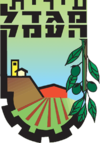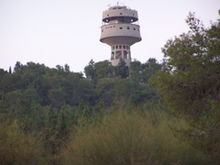- Migdal HaEmek
-
Migdal HaEmek Hebrew transcription(s) – Hebrew מִגְדַּל הָעֶמֶק – ISO 259 Migdal ha ʕemq – Also spelled Migdal HaEmeq (official) Arabic transcription(s) – Arabic مجدال هعيمق/مغدال هعيمق 
LogoCoordinates: 32°40′17″N 35°14′26″E / 32.67139°N 35.24056°ECoordinates: 32°40′17″N 35°14′26″E / 32.67139°N 35.24056°E District North Government – Type City – Mayor Elyahu Barda Area – Total 7,637 dunams (7.6 km2 / 2.9 sq mi) Population (2007) – Total 24,800 Name meaning Tower of the valley Migdal HaEmek (Hebrew: מִגְדַּל הָעֶמֶק, also officially spelt Migdal HaEmeq, Arabic: مجدال هعيمق) is a city in the North District of Israel. According to the Israel Central Bureau of Statistics (CBS), at the end of 2007 the city had a total population of 24,800.[1] There is a tower to the north-east, above the town.
Contents
History
Migdal HaEmek began in 1953 as a ma'abara, before becoming a development town. The original site of the ma'abara was west of the current site, at Shimron hill. Migdal HaEmek is built on the land of the depopulated Arab village of Al-Mujaydil.[2]
Demographics
According to CBS, in 2001 the ethnic makeup of the city was all Jewish and other non-Arabs, without significant Arab population. There are 147 immigrants.[3]
According to CBS, in 2001 there were 11,900 males and 12,200 females. The population of the city was spread out with 36.3% 19 years of age or younger, 15.6% between 20 and 29, 18.1% between 30 and 44, 15.8% from 45 to 59, 3.4% from 60 to 64, and 10.7% 65 years of age or older. The population growth rate in 2001 was 0.9%. More recently the Jewish Agency estimated Migdal HaEmek's population at 28,000, almost half of which are foreign born. Residents, both foreign-born and native Israelis, are primarily from Russia, the Caucasus, Ethiopia, Morocco, Iraq and a small group from South America.
Half of Migdal HaEmek's population is religious, a large portion of which are Ultra Orthodox thanks to the work of[citation needed] the chief rabbi of the city and 2004 Israel Prize winner Rabbi Yitzchak Dovid Grossman. He won the prize for his social service work and outreach youth programs in the city.
Income
According to CBS, as of 2000, in the city there were 8,379 salaried workers and 418 are self-employed. The mean monthly wage in 2000 for a salaried worker in the city is ILS 4,351, a real change of 5.7% over the course of 2000. Salaried males have a mean monthly wage of ILS 5,570 (a real change of 5.9%) versus ILS 3,144 for females (a real change of 3.2%). The mean income for the self-employed is 5,938. There are 646 people who receive unemployment benefits and 2,814 people who receive an income guarantee.
Education
According to CBS, there are 22 schools and 5,777 students in the city. They are spread out as 13 elementary schools and 2,995 elementary school students, and 2 high schools, and 2,782 high school students. 47.8% of 12th grade students qualified for a matriculation certificate in 2001.
Migdal HaEmek is also to home to the Jewish University, a large yeshiva that houses more than 300 students from around the world[citation needed].
Industry
Migdal HaEmek is known as "The Silicon Valley of Israel". Many hightech Israeli and global high tech companies are located in three industrial parks. Among the companies: Tower Semiconductor (foundry), RSL (Control and Diagnostic solutions for defence and commercial applications ), KLA-Tencor (inspection tools), CI Systems (electro-optical test systems, non contact temperature sensors and wet chemistry analyzers), Nilit (Nylon for textile industry and thermoplastics for industrial and commercial applications), Vishay (discrete and passive semiconductors components) and many more.
Volunteers
Every year volunteers from Habonim Dror come to Migdal HaEmek to volunteer in the community. Typically these roles include members of Kvutsat Yovel, and involve teaching in primary and secondary schools, and working with local Magen David Adom units.
References
- ^ "Table 3 - Population of Localities Numbering Above 1,000 Residents and Other Rural Population". Israel Central Bureau of Statistics. 2008-06-30. http://www.cbs.gov.il/population/new_2009/table3.pdf. Retrieved 2008-10-18.
- ^ Khalidi (1992), p 350
- ^ See Population groups in Israel
Bibliography
- Khalidi, Walid (1992). All That Remains. Washington D.C.: Institute for Palestine Studies. ISBN 0-88728-224-5
External links
Categories:- North District (Israel)
- Cities in Israel
- Development towns
Wikimedia Foundation. 2010.


